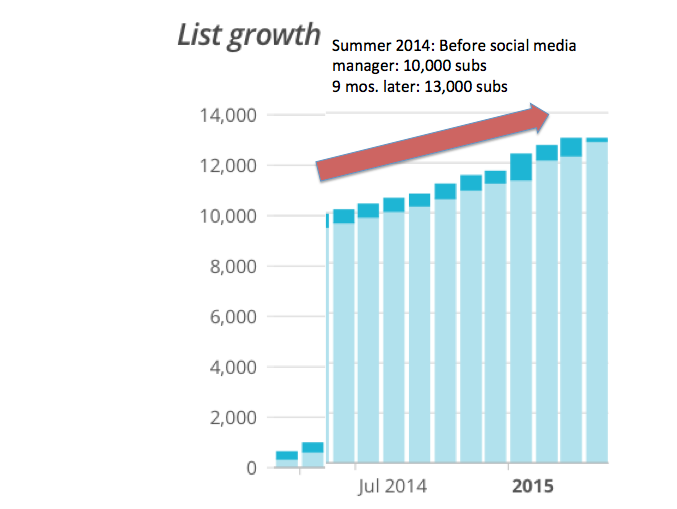
Today, I’ve got proof for you that it can.
Hiring a social media manager has been on my to-do list for a long time, but I was reluctant to commit big bucks to it.
I finally saw my opportunity a few months ago, when my son, Evan, wanted a flexible job he could do alongside his college coursework. He lives on Facebook, his smartphone is never off, he needs to earn his way, and it was money I would have to spend anyway to support him.
It seemed like a good opportunity to try training someone I could trust to take over social-media tasks, where I could closely monitor how it worked.
After a few bumps and lumps, we came up with a goof-proof plan that’s grown my audience, subscribers, and sales.
Real results in a few minutes a week
The best part? The plan we developed is super-simple, and doesn’t require any sophisticated social-media knowledge. You can do it without hiring a social media manager, and many of the techniques are free. You could also hire an affordable teen and get this done for a song.
These steps take only a few minutes a week — and I believe this social media marketing has played a major role in growing my blog traffic over the past year.
I’ll share my takeaways in three parts — the plan, the problems, and the results.
1. A simple plan
After setting up Evan on Hootsuite so he could schedule posts ahead of time, we worked out a basic set of activities that could be easily delegated. Our plan:
Have goals. Instead of just hopping on and spitting out some message off the top of my head, retweet the first few things you see, and hope that helped you, I became intentional about what I was doing in social media. We came up with concrete goals and stuck to them. This helps avoid wasting time ‘hanging out’ in social media. You do your goals, and then you’re done.
Cover the whole tweetcycle. I consider Twitter the premiere platform for promoting blog posts — it always seems to get the most use for me, wherever I post. One disadvantage of being a West Coast blogger is that by the time I get into the office at 9 a.m. or so, it’s already noon back East, and half the Twitter day is gone for a key time zone for my audience, which is about 75 percent in the U.S.
So Evan would schedule posts for 9 Eastern (6 a.m. Pacific) to get me rolling with that crowd — and we could repeat those messages later in the day, after posting a few other useful-info shares.
We program a Facebook post for early a.m. that also goes to Twitter, along with a few other early-morning tweets. I also had him hit early afternoon Pacific/late afternoon Eastern, when I’m usually busy, as there’s often another spike of Twitter use, before back-East workers go home that I was nearly always missing. If I know I’m going to be out, I can have him program more time slots.
Promote older posts. I’ve been impressed to see some bloggers who will take one post and promote it multiple times a day, for a month. Where I was usually sharing it just once!
Meanwhile, I have 700+ posts on this blog, and many of the most popular ones are still relevant. One of my biggest goals was to promote these assets and make better use of them to attract more subscribers. We optimized many of those classic posts with fresh links for current products, or a subscribe ad for the blog. That early-morning Facebook post is usually a re-socializing of one of these older posts, like this one:
Before hiring Evan, I might get 200 views and a couple likes on something like this, if I was lucky (and if I remembered to do it).
You may know Facebook now makes a point of not giving business-page posts any decent exposure unless you pay to boost them. But with Evan taking a bit of time to craft these, they do much better.
I gather he speaks Facebook chat better than I do — a strong argument for getting someone young on your social-media team — and I consistently get messages from Facebook that his posts are performing above my average.
Be more active. By getting Evan on Hootsuite to schedule posts days in advance, I could be more active in social media overall. If I had a day where I never had time to check in on these platforms, it still looked like I’d showed up. If I had time and added a few things, it was gravy. Soon, I was getting comments like, “Wow, how do you manage to be on all these places? It seems like you’re everywhere!” My profile was getting higher.
Reduce pressure to check social media. When you know you have pre-scheduled posts and tweets going out, it’s easier to resist the time-wasting compulsion to hop onto Twitter five times a day to post another update. This really helped with my productivity. No more feeling stressed that I should get up super-early to get on social media!
Cross-promote to build followers. One of the first things Evan pointed out to me is that I had 10,000 blog subscribers, a nearly equal number of Twitter followers…and only about 2,000 Facebook page followers. “That’s just wrong!” he pointed out.
He began using my Twitter audience to build up my Facebook audience by posting tweets that point to a Facebook post. He also encouraged me to hold contests on Facebook instead of in blog comments, which drove a lot more FB engagement, and helped grow my followers there by 50 percent, to over 3,000 and counting.
Make friends. My main goal for tweets was to simply share useful content my followers would like, by other entrepreneurs and freelance writing experts. If I had something to promote, I’d add that to the lineup myself. Having the regular calendar of other peoples’ stuff made it less obvious when I slipped in a promotional tweet, and made the whole channel feel less salesy.
I was expecting Evan to pick a wide variety of people to retweet, but instead he did something better: He would usually pick a few people and retweet their stuff for weeks on end. Because I shared their content repeatedly, these experts started to take notice, and I made some great new relationships this way. In some cases, these new friends were people I’d admired and had tried to connect with before, without success.
Experiment with Facebook ads. This part I do myself, working with my designer to create eye-catching graphics that Facebook will allow in ads (there are strict limits on how much text there can be). I’m still learning here, but I’ve promoted my free trainings to many thousands of writers I target on Facebook, and gotten some substantial signups through it — all without spending more than $10 a day in a typical campaign. (Trying to directly sell things that cost money on Facebook ads I believe doesn’t work that well.)
If buyers need many touchpoints before they take you seriously, this is another one I’ve created that’s raising my visibility.
Bottom line: What this all added up to in a typical week was one Facebook post and about 4-6 tweets a day, in line with our goals. Some days I came on as well and did more. But many days, I didn’t.
2. Biting off too much
What were the problems? I was all excited about having a social-media manager, and at first, I tried to go in a million directions at once. Things bogged down pretty fast. Some of our problems were specific to delegating this to a manager, and others are issues to watch out for even if you decide to tackle this yourself:
- Too many platforms. At first, I wanted to try to get Evan to post for me on four platforms — LinkedIn, Google+, Facebook, and Twitter. I created a spreadsheet with goals for each…but it was just too complicated, especially since I have LinkedIn and Facebook set to automatically also post on Twitter! This was resulting in duplicate messages on Twitter, and I came off as overly promotional. After a few months, we settled into focusing on just Facebook and Twitter.
- Technical problems. We soon learned that you can’t connect a personal G+ account to Hootsuite, only a business page. But I usually post there under my personal profile. I decided to kill off my business page on G+, and to give up on having Evan post in this channel, for now. Since LinkedIn can be done once a week or so and still be effective, I took that on myself too, leaving Evan just Facebook and Twitter (which also meant we could use free Hootsuite.)
- Too many goals. I wanted Evan to do about ten different things — all the goals above and many more, including promoting my Forbes blog and handling a lot of fast-changing promotion cycles. He was completely boggled. At this point, I delegate only two or three social-media projects at any given time, so the goals stay clear.
- Delegated critical tasks. At first, I delegated promotional campaigns to sell products. That was a mistake — timing and precise messaging on these were key, and no matter how well I calendared it for him, mistakes happened that probably cost us sales. I decided to do my own sales cycle promos (pre-scheduled on Hootsuite as well), and leave Evan to do the stuff I *never* get around to.
- Underestimated training needs. If you are hiring a social media manager, create a training manual — and then, expect to keep adding to it. Provide lots of screenshots and examples of what you like and what you want. You can’t be too specific. If you hire someone, remember that they don’t know your audience like you do — or you’ll see tweets go up that make you cringe.
3. More traffic, more subscribers
So, what’s been the result of all this extra, more targeted social-media activity? Over the past year, my traffic has grown substantially. As you can see below, a year ago, I couldn’t crack 2,000 visitors a day for love or money. Then, after bringing on my social media manager last fall, things started to accelerate.
Now, I routinely see 3,500 visitors or more. I rarely have a day below 2,000 visitors. And much of that gain comes from Facebook and Twitter, which are contributing over 2,500 visitors a month. Comparing the most recent month to the same month a year ago, traffic is up over 62 percent, from around 40,000 to about 65,000 visitors.
That additional traffic has translated into more subscribers, and in turn, more sales of classes, e-books, and my Freelance Writers Den community.
I’m compressing a big chart with 5 years of data below, so you can see what’s happened with subscribers — they grew by 30 percent:
I didn’t have a lot of free time to grow my blog traffic and build an audience during this timeframe– which is why I hired a social media manager. I wasn’t guest posting, I didn’t post on my blog more often, I didn’t do much networking…I basically had my head down, working.
We did do a redesign of the blog site for mobile — that’s about the only other major thing I can point to that happened in this time period.
Maybe some other big blogger would find these social media marketing results pretty modest — I didn’t quadruple my subscribers in a month or anything crazy like that. But I’m thrilled with the level of growth I’ve seen. I also didn’t spend much, and once we got our goals clarified, it didn’t take much effort.
How are you using social media to grow your blog? Leave a comment and share your tips.













